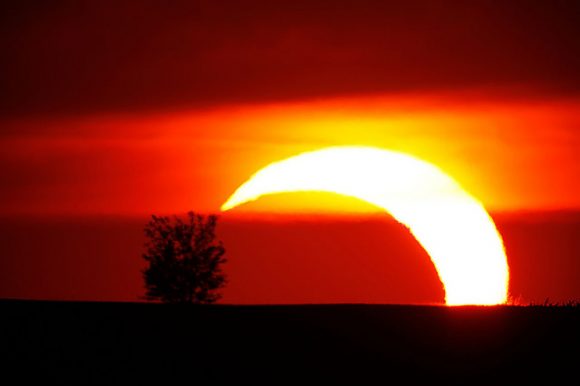
Astronomy turns up in fascinating junctures in history. Besides just the romantic angle, we can actually pin down contextual events in ancient history if we can tie them in with a spectacle witnessed in the heavens. A recent look at the story of ‘Joshua’s eclipse’ is one such possible tale.
Lunar and solar eclipses are especially dramatic events, something that would have really made the ancients stop and take notice. A recent study published in an edition of the Beit Mikra Journal (in Hebrew) by researchers from Ben Gurion University may have pinpointed a keypoint in biblical history: the date of the Battle of Gibeon.
This study first came to our attention via the Yahoo! SEML eclipse message board and a recent Times of Israel article. The article makes mention of NASA eclipse data, which is free for anyone to peruse looking over the five millennium canon of solar and lunar eclipses… hey, it’s what we do for fun.
We did obtain a look at a translation of the abstract from the paper, which ends with the following:
“In the period between 1500-1000 BCE which is the relevant time for the biblical story, there were only three eclipses seen from Jerusalem, one total eclipse and two annular eclipses. We show that the most appropriate one is the annular solar eclipse that occurred on October 30 in 1206 BCE at sunset, an appropriate date for the time of conquest and the early settlement period, at the time of Marneptah’ rule in Egypt.”
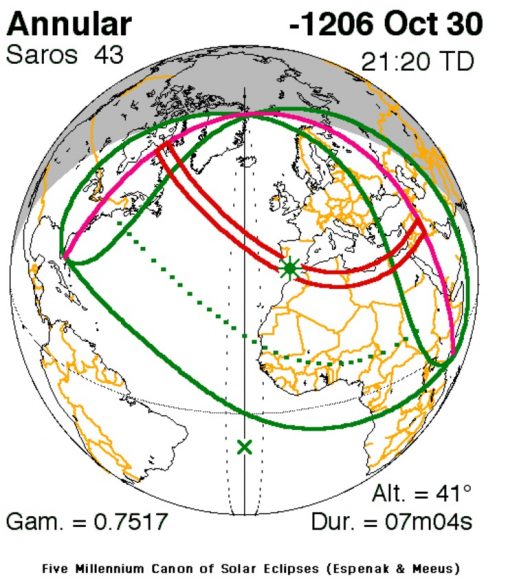
Joshua 10:12 reads: “Sun, stand still upon Gibeon; and you, Moon, in the valley of Ayalon.”
According to tradition, Joshua commanded the Sun to stand still long enough to defeat the Canaanite kings. Of course, the Sun and the Moon still move during an eclipse be it lunar or solar, though its mostly our planet that’s doing the moving. Still, the actual biblical term “-dom” is open to interpretation, and the researchers chose the Hebrew “to become dark” instead of the King James translation of “to stand still,” or “stationary”.
If this Bible verse sounds familiar, that’s because it turns up in astronomical history again in medieval Europe, when Church proponents used it as supposed proof of geocentricism.
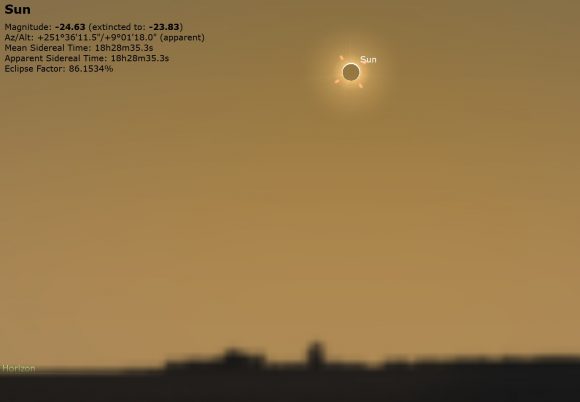
It’s tough to predict eclipses in distant time. The rotation of the Earth is not entirely smooth, and the minute change in the length of the day (known as Delta T) accumulates to the point that a leap second must be inserted on occasion to keep observed time in sync with reckoned terrestrial time. Braking action by the Sun and Moon, tectonic activity, and even global warming all cause small changes in the Earth’s rotation that slowly build up over time. This means that it’s tough to predict eclipses more than a few thousand years out, where at best we can only judge which continent they might have or will fall on.
“Not everyone likes the idea of using physics to prove things from the Bible,” said researcher Hezi Yitzhak to the Israeli news site Haaretz. “We do not claim that everything written in the Bible is true or took place… but there is also a grain of historical truth that has archaeological evidence behind it.”
The eclipse in question occurred on October 30th, 1206 BC. This was an annular eclipse, crossing the Atlantic and the Mediterranean and ending over Israel and Jordan at sunset. Researchers pegged this suspect eclipse because of its fit for historical context and visibility. Annularity for the eclipse was 86% obscuration and started at an altitude of nine degrees above the western horizon, and would have still been in progress during its final phases at sunset.
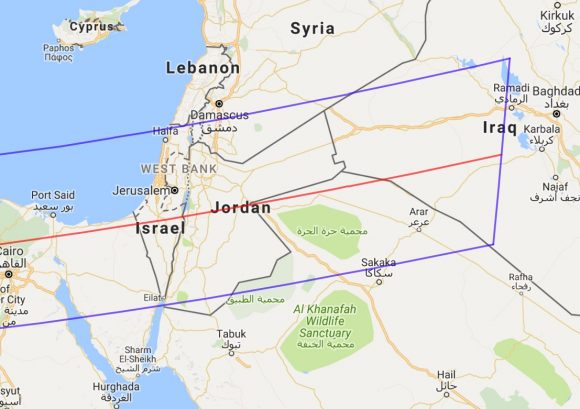
Lots of eclipses turn up in history. A partial lunar eclipse preceded the fall of Constantinople in 1453, seeming to fulfill prophecy. Solar and lunar eclipses made a showing at lots of battles, including the Second Battle of Syracuse on August 28th, 412 BC and during the Zulu War on January 22nd, 1879. A solar eclipse on June 15th, 762 BC mentioned in Assyrian texts pinpoints a crucial time in ancient history, giving us a benchmark for later dates. It’s worth noting that prior to modern times, it seems that battles were the only thing worth writing down…
Still, it’s interesting to imagine the scene as ancient armies clash, only to stop and gaze at the wondrous sight on the horizon: a pair of glowing horns, hanging low in the pre-dusk sky. We caught the 1994 annular eclipse from the Sandusky, Ohio on the shores of Lake Erie and can attest that even a 98% eclipsed Sun is still pretty bright, giving even a clear day a deep steely blue tint. Lower to the horizon though, an annular eclipse is more readily visible to the unaided eye.
You have to be careful when attempting to read ancient texts as astronomical guide books. Great minds, including Kepler and Newton, expended lots of mental juice on attempting to link biblical accounts such as Ezekiel’s Wheel and the Star of Bethlehem with actual astronomical events. We’ll probably never know for sure if a coincidental conjunction graced the sky over the manger in Bethlehem, or if Ezekiel saw the breakup of a brilliant comet, but it’s always fun to imagine and wonder. Then, there’s the inevitable embellishment that accompanies stories that may have been first sparked by meteor showers or sundogs, centuries ago. We don’t, for example, see flaming swords or banners emblazoned with Latin inscriptions across the sky today, though if you can believe medieval accounts, they seemed common back in the day.
And don’t forget: we’ve got our very own history making eclipse (hopefully sans battlefields) this coming August 21st, 2017 crossing the United States from coast-to-coast.
Though far from conclusive, the results of the study concerning Joshua’s eclipse and the battle of Gideon are interesting to consider. Most likely we’ll never truly know what happened that ancient afternoon, unless, of course, we perfect time travel. What other events remain hidden and lost to time, ready for some historical astro-sleuth to uncover them?
-Can’t get enough of eclipses, historical or otherwise? Check out our original eclipse-fueled sci-fi tales Exeligmos, Peak Season and Class Field Trip.

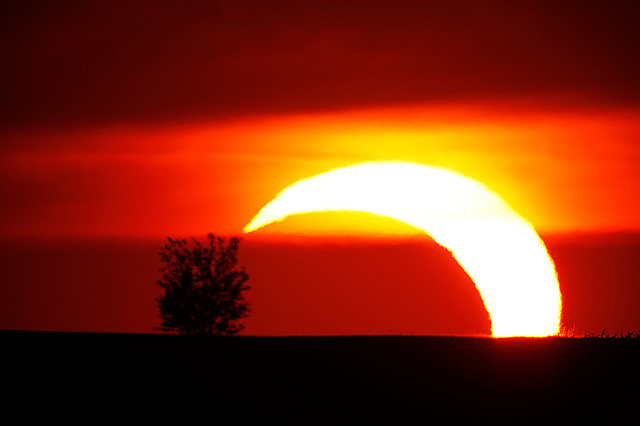
Fraser, you really ought to check the data of the articles you post. This article places Joshua’s Longest Day in 1206BC. One problem, even if you use the late date for the Exodus, Joshua was in the process of conquering the land when the Longest Day occurred. However, the stele, by the pharaoh (Merneptah) the article cites, has Israel in the land, as its ruling peoples. The stele has been reliably dated to 1207BC, a year before the date of the eclipse.
Hi Dangbert,
Thanks for pointing this out. NASA’s use of astronomical dating for BC/BCE events creates an offset of one year: https://eclipse.gsfc.nasa.gov/SEhelp/dates.html
There’s no “0 AD” in traditional dating, versus astronomical dating, where 0 AD = 1 BC.
Thanks,
Dave Dickinson
This is really crazy. It’s not crazy because of attempting to use science to prove (or disprove!) a bible story. Would be great to do that. It’s crazy because what is actually being done here is just apologising for its nonsense.
It’s written in the article:
[Quote start]
Joshua 10:12 reads: “Sun, stand still upon Gibeon; and you, Moon, in the valley of Ayalon.”
According to tradition, Joshua commanded the Sun to stand still long enough to defeat the Canaanite kings. Of course, the Sun and the Moon still move during an eclipse
[Quote end]
And there you have it: science’s work is already over as soon as Science explains how gravity works on celestial objects.
Making this out to be an eclipse event is just a lamentably poor excuse. The bible isn’t describing an eclipse. It’s describing the Sun and Moon standing still. Don’t try to prove something that is possible in principle because the presented hypothesis turns out to be impossible!
There are some things that could be reasonable:
– We can say “Okay, biblical author’s perspective is that the Sun and Moon have stopped, but actually it’s the Earth that’s stopped.”
– That’s a reasonable interpretation, because it’s just changing perspective.
But the article is even worse than suggested so far. What’s this “by tradition” nonsense? Whose tradition? Just take the plain simple words the bible says! And the part of the story you didn’t quote says,
– “On the day the Lord gave the Amorites over to Israel”: so the claim to be investigated is not that it happened at any time, but for something that could have happened on-cue, for a particular event, or by incredibly coincidence with it.
– It says, “The sun stopped in the middle of the sky and delayed going down about a full day.” Do you omit this sentence because that completely puts to bed the Eclipse hypothesis, or because you claim that the peasants were so incredibly stupid, if you turn out the lights then twenty minutes is like unto 24 hours?
– And finally, regarding the “Partial Eclipse”, anyone who has seen a partial eclipse knows that it’s not that big an event… pretty easy to miss if you’re not looking for it. The atmosphere is brought by the crowd who are waiting in awed expectation. The sky gets a bit less light, but not so much as when a cloud passes in front of the sun. If the verse had read, “And behold, we looked up into the sky and The Lord up on high had been peckish and had taken out of the sun a bite to satiate himself”, that would sound like the definition of a partial eclipse. This article, on the other hand, is entirely incompatible with the explanation. Given Joshua 10:10 (also omitted from the article) who would be taking notice of what the sun was doing?
“The Lord threw them into confusion before Israel, so Joshua and the Israelites defeated them completely at Gibeon. Israel pursued them along the road going up to Beth Horon and cut them down all the way to Azekah and Makkedah. 11 As they fled before Israel on the road down from Beth Horon to Azekah, the Lord hurled large hailstones down on them, and more of them died from the hail than were killed by the swords of the Israelites.”
Hailstones rained and confusion reigned, and if any of the things described happened at all, the sun/moon stopping for a day did not happen.
The first thing to check is which calendar, and how the dates were calculated.
There is a five or six year offset because when the pope had the calender updated from Julian to Gregorian the priest made several errors such as no year Zero etc.
By the current calender, King Herod was dead for over two years when Jesus of Nazareth was born. These errors also make it likely that the star of Bethlehem was the nova that was reported by the Chinese in 5BC.
This does not exclude that there is another error somewhere. Warning, humans were involved.
Quick note: The King James translation of the bible into English is in my opinion, atrocious. The Good News Translation is better, but it still has a lot of problems. Example: A few corrections, Moses did not cross the Red Sea, He crossed the Sea of Reeds. (Martin Luther also made this mistake when he wrote the German translation.) The translation that it became dark is correct. The translation that the sun stood still is wrong. The reason I have such a poor opinion of the King James translation is that I subscribe to the online Academic Journals covering this subject. It is a real eye opener.
It is enough to turn any Fundamentalist into an Inspirationalist.
Chfosmith said “the Good News Translation is better”. Actually that’s the first time I’ve ever heard said that anything in the Good News translation is better than anything. 🙂 Bible scholars at all levels seem to fall over themselves to say how bad it is.
But it’s an interesting thing to discuss: what’s your translation of the Hebrew, and how do you justify the difference from theirs?
I’ve read the full article in Hebrew. Let us ignore all other things and just relate to the description of the sun as not setting as usual but later, which is a complete contradiction for the eclipse which is like an earlier sunset.
Thanks Gadi. I almost recruited you for translation, didn’t know how busy you were. Any insights always welcome.
Thanks,
Dave Dickinson